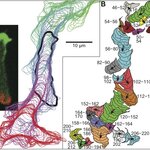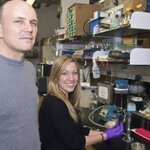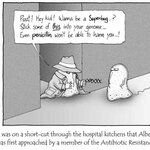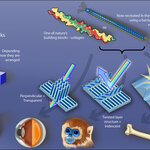Microbiology

Alphabodies cross over the boundaries between biologics and small chemical drugs
Complix NV, a biopharmaceutical company focused on the discovery and development of Alphabodies, a class of protein therapeutics that are active against both extracellular and intracellular disease targets, announces that it will provide an update on new developments with its Alphabody(TM) platform at the Biologics Partnering Forum in Boston, MA on 29 April 2012.
Dr. Mark Vaeck, CEO of Complix, will highlight in his presentation the potential of the Company's Alphabody platform to transform protein…

At one time, J. Craig Venter, Ph.D., was a maverick outsider, determined to beat Big Science to the human genome and at a lot less cost. Now he is the ultimate insider, giving a plenary talk at the most recent American Chemical Society meeting.
Venter 's talk described a fundamental shift in his field of genomics and its promise for producing synthetic life that could help provide 21st century society with new fuels, medicines, food and nutritional products, supplies of clean water and other resources. He isn't wrong all that often so his words have weight. He went…

Imagine, if you will, that your computer screen (or iThingie, or DroidDevice) were to suddenly explode, driving a shard of shrapnel deep into your shoulder. Very quickly, your white blood cells would sense the intruder and rush to the site of the insult, hunt down invading bacteria, and just generally do what they do. But if you think about it, these are single cells! How does a single cell sense where to go, and then keep moving in that direction? White blood cells aren’t the only cells that have this ability – amoebas hunt down their bacterial prey in a very similar…

Where would we be without fungi and microbes to break down dead trees and leaf litter in nature? Up to our eyeballs in arborial garbage, that's where.
But such biomass destruction goes on every day - understanding this process of selective ligninolysis is of longstanding interest to the pulp and paper industry. According to the American Forest&Paper Association, approximately $175 billion worth of forest products such as pulp and paper are produced annually, and account for five percent of the nation's GDP. Studying fungi is pulp nonfiction, according to the researchers doing massive-…

Archaea, one of the three "domains of life" on Earth - the other two being bacteria and eukaryota (plants and animals) - strangely do not seem to be part of any food chain.
But maybe they soon will be - and it just might help solve future climate change issues. Archaea, a type of single-celled microorganism, perform many key ecosystem services including being involved with nitrogen cycling, and they are known to be the main mechanism by which marine methane is kept out of the atmosphere.
One of the basic questions scientists have asked is whether this life form could act as a food…

What if bacteria could talk? Or use touch? A new study hypothesizes that bacterial cells may need to communicate in order to perform certain functions. The researchers studied uropathogenic E. coli (UPEC), which causes urinary tract infections in humans, and discovered a sibling-like link between cell systems that have largely been thought of as rivals. The paper shows that bacteria expressing a contact-dependent growth inhibition system (CDI) can inhibit bacteria without such a system, but only if the target bacteria have CysK, a metabolic enzyme required for synthesis of the amino acid…

Bacteria can multiply rapidly, potentially doubling every 20 minutes in ideal conditions but this exponential growth phase is preceded by a period known as lag phase, where no increase in cell number is seen. Lag phase was first described in the 19th Century, and was assumed to be needed by bacteria to prepare to exploit new environmental conditions - they are basically Zombies. Beyond this, surprisingly little is known about lag phase, other than bacteria are metabolically active in this period. But exactly what are bacteria doing physiologically during that time?To fill in this knowledge…
In November 2011, NASA launched its biggest, most ambitious mission to Mars. The $2.5 billion Mars Science Lab spacecraft will arrive in orbit around the Red Planet this August, releasing a lander that will use rockets to control a slow descent into the atmosphere. Equipped with a “sky crane,” the lander will gently lower the one-ton Curosity rover on the surface of Mars.
Curiosity, which weighs five times more than any previous Martian rover, will perform an unprecedented battery of tests for three months as it scoops up soil from the floor of the 96-mile-wide Gale Crater. Its mission, NASA…

Antibiotic resistance is a huge problem. More and more resistant strains of microbes are appearing. Needless to state that this has a huge human and economic cost. Combining this with the increasing globalization, the threat of a global outbreak of an infection caused by a multidrug-resistant bacterium looms over our heads as Damocles’ sword. This perhaps sounds too ominous, but it speaks for itself that research into the development of antibiotic resistance could prove very useful.
To explore this problem, a group of scientists gathered in Cold Spring Harbor, NY at the Banbury Conference…

Using a single-step process, researchers recently developed a technique to cause M13 phages to become building blocks for materials with a wide range of properties.
These benign viruses self-assembled into hierarchically organized thin-film structures, with complexity that ranged from simple ridges, to wavy, chiral strands, to truly sophisticated patterns of overlapping strings of material. Each film presented specific properties for bending light, and several films were capable of guiding the growth of cells into structures with precise physical orientations.
The fundamental unit of the…